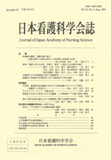Japanese
English
- 販売していません
- Abstract 文献概要
- 参考文献 Reference
- サイト内被引用 Cited by
要旨
子どもが検査・処置をどのように体験しているのかを明らかにすることを目的として参加観察を行い,子どもが処置を体験するプロセスの中で「覚悟」という現象と,覚悟に至る要因が抽出された.処置を受ける子どもと親,および処置を担当した看護者・医師の4者18組を対象とし,おもにgrounded theory approachを用いて,処置場面の参加観察,および処置に対する思い・説明内容等について半構成的インタビューを実施し分析を行った.その結果,以下のことが明らかとなった.
子どもの“覚悟”という現象は,「処置を受けるにあたり,情緒的・認知的・精神運動的側面のバランスをとり,処置を主体的に受容している状態」であった.そして,覚悟に影響を与える要因として【まわりのゆとり】【過去の経験のイメージ】【子どもが選択できる可能性】【まわりとの一体化】【処置に対する代償利益の確認】【自らする覚悟の宣言】が挙げられた.
覚悟に影響する6つの要因はどれもが子どもの自我機能強化につながっており,その強化の仕方によって,①子ども自身がもともと持っている認知・情動との調整をはかって行動化する力(自我機能)が十分に発揮されるあり方,②子どもが認知と情動との調整をはかる主体であるということをまわりも認めることで,子どもが自己コントロール感を取り戻し,自ら行動化しやすくなるあり方,③子どもの中で拭いきれない強い情動のゆれ(自我機能を弱めさせる外界からの力)にタイミングよくふんぎりをつけさせて行動化できるあり方,の3つに大別され構造化されていた.
Abstract
The purpose of this study is to clarify the child's experience when he/she is facing a procedure and/or treatment. The design of the study was a inductive qualitative method. The data was obtained through observation and interview. The grounded theory approach was used to analyze the data. Children who are receiving procedure/treatment were observed. Interview was conducted to 18 paired of child, parent, nurse, and physician who had participated in the child's procedure/treatment.
When children were facing and starting the procedure and treatment, children seem to go through the emotional/cognitive state to determine to accept the consequence. We had named this phenomena as a“Kakugo” of the child. Furthermore, when the child had to do Kakugo, the child was balancing emotion, cognition, and psychomotor aspects. After the Kakugo, the child would face the procedure/treatment with full acceptance. Factors influence the child's Kakugo were identified as following: people surrounding the child, image of past experience, possibility of child choice of action, feeling oneness with people surrounding, some benefit for procedure/treatment, and declaration of own Kakugo.
Above mentioned factors were summarized into three ways to strengthen the child's ability to control the situation. The first one is to promote child's potential to utilize his/her ego power to balance cognition and emotional preparedness. The second is participant's understanding of the child as the primary person who has to balance his/her emotion and cognition. This understanding would enhance the feeling of self-control in the child which will promote child's ability to control his/her behavior. The third is for the child to find a good timing with others to make a Kakugo which lead the child to take action.
Copyright © 2001, Japan Academy of Nursing Science. All rights reserved.


